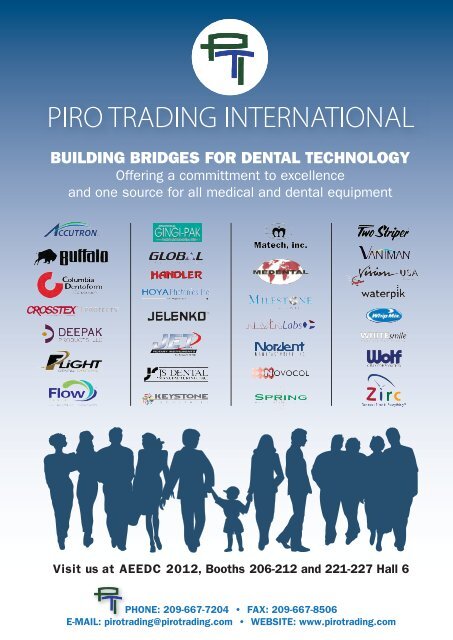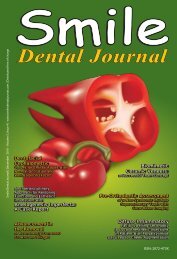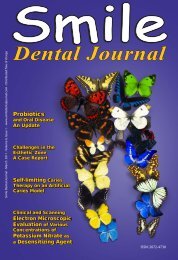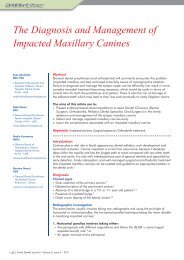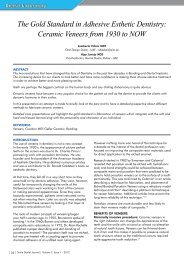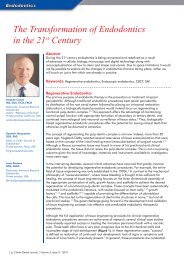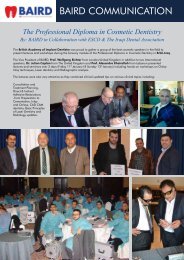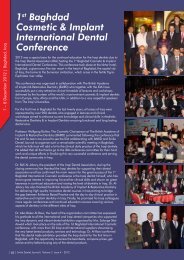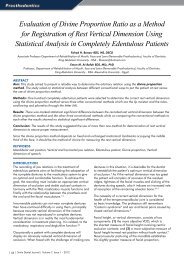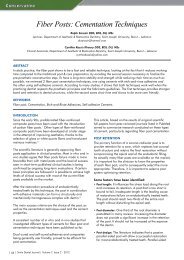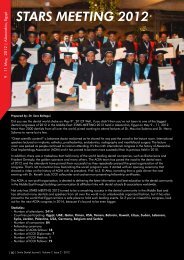Download e-copy - Smile Dental Journal
Download e-copy - Smile Dental Journal
Download e-copy - Smile Dental Journal
Create successful ePaper yourself
Turn your PDF publications into a flip-book with our unique Google optimized e-Paper software.
Introduction<br />
Zygomatic or Malar bone fractures are (2 nd most<br />
common) after nasal bone fractures among facial<br />
skeletal Injures. 1,2 The high incidence of these fractures<br />
may probably be attributed to the fact that Zygoma’s<br />
occupy an anatomically prominent position within the<br />
facial skeleton which frequently exposes it to traumatic<br />
forces. The prominent convex shape of the zygoma<br />
makes it vulnerable to traumatic injury. Even minimally<br />
displaced zygomatic-complex fractures can result in<br />
functional and aesthetic deformities. All traumas to the<br />
face, particularly above the level of the mouth, require<br />
a careful ocular examination including an estimation<br />
of visual acuity of each eye, and zygomatic-complex<br />
fractures are frequently complicated by injury to the orbit<br />
and eye adnexae, which are the most serious negative<br />
outcomes of zygomatic complex fractures. 3<br />
Patients and Methods<br />
Information for the study was gathered from patient<br />
records and a self-administrated patient questionnaire<br />
over a period of six months from 10-1-2005 to 20-<br />
7-2005. Fifty patients, who had sustained zygomaticcomplex<br />
fractures were examined clinically, radiographicaly,<br />
and also underwent orthoptic investigations.<br />
A written informed consent was obtained from the<br />
patient or attendant. The treatment of fractures was done<br />
by standard methods of reduction and fixation. Data<br />
was analyzed in statistical program for social sciences<br />
(SPSS) version 11.0. The frequency and percentage<br />
was computed for qualitative variables, like gender,<br />
etiologies, pattern and management modalities. Mean±<br />
standard deviation was computed for qualitative<br />
Variables, like age. Ethical approval was gained from the<br />
local research ethics.<br />
Results<br />
The results of this study were described in sequence of<br />
the objectives. Detailed description of separate results is<br />
shown in figures and tables.<br />
Discussion<br />
The zygomatic complex gives the cheek prominence, and<br />
it is the second most common mid-facial bone fractured<br />
after the nasal bone and, overall, represents 13% of<br />
craniofacial fractures. 4 Zygomatic complex fractures are<br />
almost always associated with fractures of the floor of the<br />
orbit. Typically, a fracture line extends from the inferior<br />
orbital fissure antero-medially along the orbital process<br />
of the maxilla, toward the infra-orbital rim.<br />
Fifty patients attended with zygomatic complex fractures<br />
over a six months period. The age of the patients ranged<br />
from 17 to 75 years. Seventy six percent of patients were<br />
male, and the mean and median ages were (32.3; 30.5)<br />
for males, and (33.4; 30.5) for females respectively. The<br />
male to female ratio was 3:1 as shown in table 1.<br />
Age<br />
Range<br />
Number<br />
of patient<br />
Male Female Total<br />
%<br />
Number<br />
of patient<br />
Assault was the major cause of zygomatic complex<br />
fractures, (35 patients [70%]), and the second most<br />
common cause was sport (8 patients [16%]). The<br />
majority of assault cases were in the 24-28 age groups.<br />
This corresponds with results in comparable studies 5-8 as<br />
shown in figure 1.<br />
Of the patients who required surgical intervention,<br />
8 (16%) were treated within 4-7 days and 19 (38%)<br />
in 8-13 days. In 23 patients (46%) surgery was not<br />
undertaken until 14 days. The reasons for this may<br />
include allowing the oedema and ecchymosis to settle<br />
and for the general condition of the patients to improve 9<br />
as shown in figure 2.<br />
We also evaluated the site of injury to whether it was<br />
left-side or right, and compared this to aetiology of the<br />
fracture. There was a statistically significant difference<br />
between aetiologies and sites of injuries with left side<br />
%<br />
Total<br />
number of<br />
patient<br />
14-18 4 8 0 0 4 8<br />
19-23 2 4 2 4 4 8<br />
24-28 12 24 4 8 16 32<br />
29-33 5 10 1 2 6 12<br />
34-38 6 12 2 4 8 16<br />
39-43 4 8 1 2 5 10<br />
44-48 3 6 0 0 3 6<br />
Over<br />
48<br />
2 4 2 4 4 8<br />
Total 38 76 12 24 50 100<br />
(Table 1) Age and sex of study group<br />
16<br />
14<br />
12<br />
10<br />
8<br />
6<br />
4<br />
2<br />
0<br />
14-18<br />
19-23<br />
24-28<br />
29-33<br />
34-38<br />
39-43<br />
(Fig. 1) Aetiology by age distribution<br />
44-48<br />
Over 48<br />
%<br />
Total<br />
Others<br />
Industrial<br />
Road Trafic<br />
Accident<br />
Sport<br />
Fall<br />
Assault<br />
<strong>Smile</strong> <strong>Dental</strong> <strong>Journal</strong> | Volume 6, Issue 4 - 2011| 33 |


